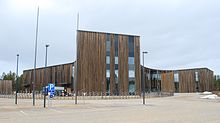Sámi Parliament of Finland
Sámi Parliament of Finland Northern Sami: Sámediggi Inari Sami: Sämitigge Skolt Sami: Sääʹmteʹǧǧ Finnish: Saamelaiskäräjät Swedish: Sametinget | |
|---|---|
| Type | |
| Type | |
| History | |
| Founded | 9 November 1973 |
| Preceded by | Finnish Sámi Council |
| Leadership | |
Speaker | Tuomas Aslak Juuso since February 28, 2020 |
| Seats | 25 |
| Elections | |
Last election | 2023 |
Next election | 2027 |
| Meeting place | |
 | |
| Sajos, Inari, Finland | |
| Website | |
| www | |
The Sámi Parliament of Finland (Finnish: Saamelaiskäräjät, Northern Sami: Sámediggi, Inari Sami: Sämitigge, Skolt Sami: Sääʹmteʹǧǧ) is the representative body for people of Sámi heritage in Finland. The parliament consists of 21 elected members and 4 elected deputy members.[1] As of 2020, the president is Tuomas Aslak Juuso.[2]
History
[edit]The passage of a "Sámi Act" by the Finnish Parliament and the creation of a central "Sámi Administration" to secure Sámi economic and political development and cultural self-expression were the recommendation of both the 1949-1951 and 1971-1973 Sámi Committees on State Affairs.[3] After a trial election in 1972 with 2,649 eligible Sámi voters and a turnout rate of 72.6%,[3] the Finnish Sámi Delegation (Sámi parlameanta in Northern Sámi, Finnish: Saamelaisvaltuuskunta in Finnish) was created by decree on 9 November 1973. The 20 delegates elected in the trial election sat in the Sámi Delegation of 1973–1976.[3]
Its successor,[4] the Sámi Parliament (Northern Sami: Sámediggi) was legislated in 1995 and signed by President Martti Ahtisaari[1] on 17 July 1995. This law was amended and a decree[5] passed on 22 December 1995. On 2 March 1996, the Sámi parlameanta officially became/was replaced by Sámediggi.
Location
[edit]
The Finnish Sámi Parliament is located in Sajos in Inari.
Responsibilities
[edit]Some of the responsibilities of the Finnish Sámi Parliament include matters related to the languages and culture of the Sámi, and also their status as an indigenous people. The Finnish Sámi Parliament decides on the distribution of the funds it receives that are earmarked for use by the Sámi. It can also sponsor bills and release statements on matters that fall under its jurisdiction.
The Finnish Sámi Parliament is a separate branch of the Ministry of Justice and is an independent legal body subject to public law with its own governing body, accountants as well as auditors.
The parliament has working groups for: education and education material, Sámi livelihood and rights, culture, social issues and health, election, and Sámi language.
The Sami Parliament has an annual budget of about €2 million.[6]
Voting system
[edit]The Finnish Sámi Parliament has 21 representatives and four deputy representatives who are elected every four years by postal vote. The four municipalities in the Sámi Domicile Area (Enontekiö, Utsjoki, Inari and Sodankylä) elect three members and one deputy member each, and the remaining nine members are elected from those candidates who received the highest share of the votes (regardless of which municipality they live in, or whether they live outside the Sámi Domicile Area).[7]
Under the Section 3 of the Act on the Sámi Parliament[1] a person is eligible to vote if they consider themselves as a Sámi, and:
- They, or one of their parents or grandparents was native Sámi speaker, or
- They are descended from a person in the mountain, forest, or fisher Lapp Sámi register (tunturi-, metsä tai kalastajalappalaiseksi), or
- At least one of their parents are, was, or could have been, eligible for voting at the Sámi Parliament of 1995 or the Sámi Council of 1973.
Elections
[edit]In 2016, the Sámi Parliament sought to hold a new election following the results of the 2015 election, which ran between 7 September and 4 October. The Supreme Administrative Court of Finland ruled that the move to organise a new election was illegal, and the October results stood.[6] Turnout was 51.63%.[8]
2,853 votes were cast in the September 2019 election, which represents turnout of 48.58% of the 5,873 on the Sámi electoral roll.[7][8] Nine members were re-elected, eight members were elected for the first time and four candidates who had previously been members were elected.[8]
See also
[edit]References
[edit]- ^ a b c "Act on the Sámi Parliament (974/1995; amendments up to 1026/2003 included, laki saamelaiskäräjistä)" (PDF). Finlex. Retrieved 25 January 2015.
- ^ Paltto, Anni-Saara (28 February 2020). "Tuomas Aslak Juuso válljejuvvui Sámedikki ođđa ságadoallin" (in Northern Sami). Yle. Retrieved 28 February 2020.
- ^ a b c Müller-Wille, Ludger (1979). "The Sami Parliament in Finland: A model For ethnic minority management?". Études/Inuit/Studies. 3 (2): 63–72. ISSN 0701-1008. JSTOR 42869458.
- ^ "The Sámi Parliament – The representative self-government body of the Sámi". Sámediggi. Retrieved 14 January 2021.
- ^ "Asetus saamelaiskäräjistä 22.12.1995/1727" [Decree on the Sámi Parliament]. Finlex (in Finnish). Retrieved 25 January 2015.
- ^ a b "Court: No new Sámi parliament election in Finland". Yle Uutiset. 15 January 2016. Retrieved 2021-01-14.
- ^ a b Staff, News Now (2019-10-01). "Low turnout as Sámi Parliament election results announced | News Now Finland". Retrieved 2021-01-14.
- ^ a b c "The Sámi elections in Finland, an ancient people tries to rule itself in a tumultuous Europe". www.inarilainen.fi (in Finnish). Retrieved 2021-01-14.
External links
[edit] Media related to Sami Parliament of Finland at Wikimedia Commons
Media related to Sami Parliament of Finland at Wikimedia Commons- Sámi Parliament of Finland
